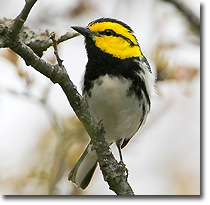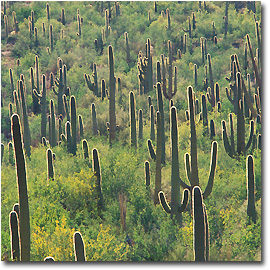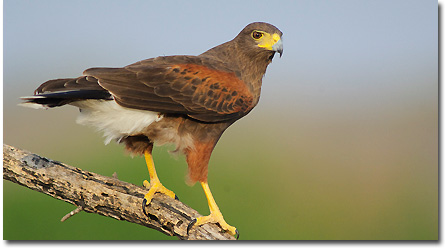Aridlands
Unique Birds of the Aridlands Face Habitat Loss and Degradation
|
|
The State of Aridland Birds
|
Of 83 aridland-breeding bird species, 39% are species of conservation concern, including 10 federally listed as endangered or threatened. These species are especially vulnerable because of their small ranges or restricted habitat requirements, or both. Sixty percent of all aridland species and 76% of aridland obligate species have declined. The aridland birds indicator, based on 17 of 30 obligate species with sufficient data, shows a steady decline over the past 40 years, to nearly 30% below the baseline value. An additional 13 species, including nine species of conservation concern, are not adequately monitored. |
A regional system of protected areas can enhance quality of life for
people and enable birds to survive.
Aridland Birds
Indicator
Birds in Trouble
 |
Golden-cheeked Warbler
|
- Endangered Golden-cheeked Warblers depend on ash-juniper woodlands
that are being cleared for agriculture or suburban development in the
Texas hill country.
- Species such as Elf Owl, Bendire’s and LeConte’s thrashers, and
Gilded Flicker are of conservation concern because of their small
range, known threats, or declining populations.
- Resident game birds that depend on aridlands, including Greater and Gunnison’s sage-grouse and Scaled Quail, have suffered significant declines and are threatened by continued degradation of their fragile habitats. About 45% of potential sagebrush habitat has been converted to other habitat types, including agriculture and urban areas.
 |
Aridlands in the U.S. include the Sonoran Desert (shown here), Chihuahuan, Mojave, and Great Basin deserts, and major shrub-scrub ecoregions (coastal California chaparral, Edwards Plateau, Colorado Plateau). Aridlands are characterized by low annual precipitation with variability from one year to the next. Photo by Gerrit Vyn |
Major Threats
Development and Energy
Unplanned and sprawling urban development is by far the greatest threat to aridlands. Some of our nation’s fastest growing cities are in aridlands (e.g., Los Angeles, Phoenix, Las Vegas, San Diego).
Coastal sage and chaparral of southern California represent a global biodiversity hotspot with numerous threatened or endangered plants and animals. About 40% of the area is now urban or suburban, supporting nearly half of California’s human population.
Energy development and exploration have major impacts on aridland birds. Poorly planned energy infrastructure degrades and fragments habitat and provides conditions favorable for invasive plant species.
 |
| Greater Sage-Grouse by Ted Schrodeder |
Invasive nonnative plants are a serious threat to virtually all aridlands. In the Great Basin and other areas, more than 17% of remaining sagebrush is dominated by introduced grasses such as cheatgrass. Invasive grasses fuel wildfires that devastate sagebrush and desert plant communities, eliminating native plants that evolved in the absence of fire.
Unsustainable livestock ranching practices have degraded habitat and damaged soils, fostering areas dominated by nonnative plants.
Climate change
The impact of climate change in aridlands is difficult to predict, but warmer conditions and changes in precipitation may dramatically affect the production of seeds needed by birds. Improved monitoring of bird populations may provide the first indications of changes to habitats.
 |
|||||
| Harris's Hawk by Gerrit Vyn | |||||
Solutions
Proactive conservation measures, such as ensuring sustainable agriculture and environmentally sustainable energy development, are needed to reverse declines of native aridland birds.
Linking the protected lands system with “smart growth” in
communities will provide opportunities for people to enjoy birds, as
well as for birds to move and adapt to increasing pressure from
development.
Immediate, innovative efforts are needed to encourage the coexistence
of agriculture and native birds, including wildlife-compatible grazing
practices, maintenance of native habitat patches, and planting native
seed mixes in disturbed areas.
Continual efforts must be made to prevent invasive plants from spreading in areas most affected by wildfire.
Beyond Our Borders
More than 50% of aridland birds are permanent residents of the U.S. borderlands. Effective conservation requires close collaboration with the Mexican government and private conservation organizations. Most migratory species winter in Mexico and Central America, including the endangered Golden-cheeked Warbler. New and existing international partnerships must be supported to ensure the survival of aridland birds.
 |
California Condor by Brian
L.
|
Reasons for Hope
Endangered California Condors and Aplomado Falcons have been reintroduced to areas where they had been extirpated in the United States. Public lands have provided important habitats for these species. Today, 174 condors are flying free, and the number grows each year.
Vast areas of public land managed by the Bureau of Land Management and Department of Defense offer opportunities to protect and manage habitats for aridland birds.













